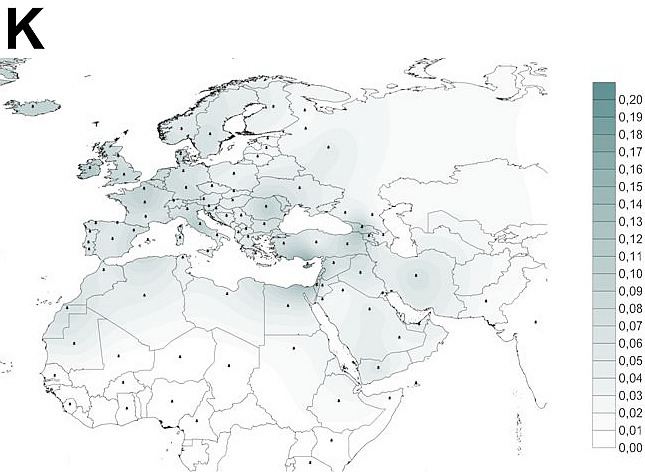Possible time of origin ~12,000 years Ancestor U8b'K | Possible place of origin Western Asia Descendants K1, K2 | |
 | ||
Defining mutations 3480 10550 11299 14798 16224 16311 | ||
Haplogroup K is a human mitochondrial DNA (mtDNA) haplogroup. It is defined by the HVR1 mutations 16224C and 16311C.
Contents
Origin
Haplogroup K is believed to have originated around 12,000 years ago in Western Asia, quite likely in the Caucasus.
It is the most common subclade of haplogroup U8b, with an estimated age of c. 12,000 years BP.
Distribution
Haplogroup K appears in West Eurasia, North Africa, the Horn of Africa and South Asia, and in populations with such an ancestry. Haplogroup K is found in approximately 10% of native Europeans. Overall mtDNA Haplogroup K is found in about 6% of the population of Europe and the Near East, but it is more common in certain of these populations. Approximately 16% of the Druze of Syria, Lebanon, Israel, and Jordan, belong to haplogroup K. It is also found among 8% of Palestinians. Additionally, K reaches a level of 17% in Kurdistan.
Approximately 32% of people with Ashkenazi Jewish ancestry are in haplogroup K. This high percentage points to a genetic bottleneck occurring some 100 generations ago. Ashkenazi mtDNA K clusters into three subclades seldom found in non-Jews: K1a1b1a, K1a9, and K2a2a. Thus it is possible to detect three individual female ancestors, who were thought to be from a Hebrew/Levantine mtDNA pool, whose descendants lived in Europe. Recent studies suggest these clades originate from Western Europe.
The average of European K frequency is 5.6%. K appears to be highest in the Morbihan (17.5%) and Périgord-Limousin (15.3%) regions of France, and in Norway and Bulgaria (13.3%). The level is 12.5% in Belgium, 11% in Georgia and 10% in Austria and Great Britain.
Haplogroup K is also found among Gurage (10%), Syrians (9.1%), Afar (6.3%), Zenata Berbers (4.11%), Reguibate Sahrawi (3.70%), Oromo (3.3%), Iraqis (2.4%), Saudis (0%-10.5%), Yemenis (0%-9.8%), and Algerians (0%-4.3%).
Ancient DNA
Haplogroup K has been found in the remains of three individuals from the Pre-Pottery Neolithic B site of Tell Ramad, Syria, dating from c. 6000 BC. The clade was also discovered in skeletons of early farmers in Central Europe dated to around 5500-5300 BC, at percentages that were nearly double the percentage present in modern Europe. Some techniques of farming, together with associated plant and animal breeds, spread into Europe from the Near East. The evidence from ancient DNA suggests that the Neolithic culture spread by human migration.
Analysis of the mtDNA of Ötzi, the frozen mummy from 3300 BC found on the Austrian-Italian border, has shown that Ötzi belongs to the K1 subclade. It cannot be categorized into any of the three modern branches of that subclade (K1a, K1b or K1c). The new subclade has provisionally been named K1ö for Ötzi. Multiplex assay study was able to confirm that the Iceman's mtDNA belongs to a new European mtDNA clade with a very limited distribution amongst modern data sets.
A woman buried some time between 2650 and 2450 BC in a presumed Amorite tomb at Terqa (Tell Ashara), Middle Euphrates Valley, Syria carried Haplogroup K.
A lock of hair kept at a reliquary at Saint-Maximin-la-Sainte Baume basilica, France, which local tradition holds belonged to the biblical figure Marie-Madeleine, was also assigned to haplogroup K. Ancient DNA sequencing of a capillary bulb bore the K1a1b1a subclade, indicating that she was likely of Pharisian maternal origin.
Haplogroup K1 has likewise been observed among specimens at the mainland cemetery in Kulubnarti, Sudan, which date from the Early Christian period (AD 550-800).
Tree
This phylogenetic tree of haplogroup K subclades is based on the paper by Mannis van Oven and Manfred Kayser Updated comprehensive phylogenetic tree of global human mitochondrial DNA variation and subsequent published research.
Genetic traits
A study involving Caucasian patients showed that individuals classified as haplogroup J or K demonstrated a significant decrease in risk of Parkinson's disease versus individuals carrying the most common haplogroup, H.
In popular culture
In his popular book The Seven Daughters of Eve, Bryan Sykes named the originator of this mtDNA haplogroup Katrine.
On an 18 November 2005 broadcast of the Today Show, during an interview with Dr. Spencer Wells of The National Geographic Genographic Project, host Katie Couric was revealed to belong to haplogroup K. [2]
On 14 August 2007, Stephen Colbert was told by geneticist Spencer Wells that he is a member of this haplogroup during a segment on The Colbert Report.
Henry Louis Gates Jr. states that Meryl Streep belongs to Haplogroup K in his book "Faces of America".
